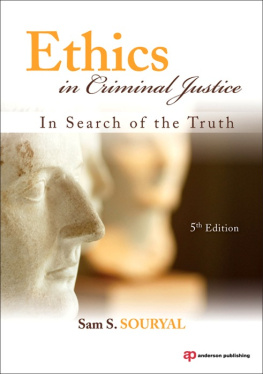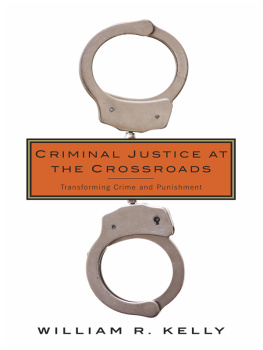The Concise Dictionary of Crime and Justice
Second Edition
The Concise Dictionary of Crime and Justice
Second Edition
FOR INFORMATION:
SAGE Publications, Inc.
2455 Teller Road
Thousand Oaks, California 91320
E-mail: order@sagepub.com
SAGE Publications Ltd.
1 Olivers Yard
55 City Road
London EC1Y 1SP
United Kingdom
SAGE Publications India Pvt. Ltd.
B 1/I 1 Mohan Cooperative Industrial Area
Mathura Road, New Delhi 110 044
India
SAGE Publications Asia-Pacific Pte. Ltd.
3 Church Street
#10-04 Samsung Hub
Singapore 049483
Copyright 2016 by SAGE Publications, Inc.
All rights reserved. No part of this book may be reproduced or utilized in any form or by any means, electronic or mechanical, including photocopying, recording, or by any information storage and retrieval system, without permission in writing from the publisher.
Printed in the United States of America
Cataloging-in-publication data is available for this title from the Library of Congress.
ISBN 978-1-4833-8093-3
This book is printed on acid-free paper.
15 16 17 18 19 10 9 8 7 6 5 4 3 2 1
Acquisitions Editor: Jerry Westby
Editorial Assistant: Laura Kirkhuff
Production Editor: Kelly DeRosa
Copy Editor: Janet Ford
Typesetter: C&M Digitals (P) Ltd.
Proofreader: Sue Irwin
Cover Designer: Karine Hovsepian
Marketing Manager: Terra Schultz
Preface to the New Edition
People working in criminal justice rely on a number of tools to make their jobs easier. Professors keep their lectures fresh by incorporating the latest research published in scholarly journals. Practitioners search for best practices to help them achieve improved outcomes with their clients. But, whether you are a professor, a student, a practitioner, a journalist, or a novelist, access to the vocabulary of crime and justice is a must.
This updated and expanded edition is designed to serve as one of those tools. It is intended to be a comprehensive, though not exhaustive, guide to the vocabulary of contemporary criminal justice. If readers require a greater depth of information, they can consult reference works, such as encyclopedias of crime and justice. In some cases, they may want to consult specialty dictionaries, such as those focusing on law, forensic science, or biographies. There are also a number of websites that offer more extensive treatment of selected topics. However, for many readers this dictionary will meet their needs.
Since the last publication, a vast number of changes in society and in the field of criminal justice argued for a new edition of this dictionary. For one, the face of crime is changing. Terrorism is now such an integral part of the crime picture that a number of universities have created special terrorism centers to study its contours and effects. Unfortunately, mass shootings are almost a weekly occurrence, creating an ongoing debate over guns and violence. In recent years, assaults against the environment have received increased attention, resulting in a growing number of criminologists who study so-called green criminology.
These and other changes in society are also making criminology and criminal justice increasingly interdisciplinary. For decades, criminology was dominated by sociology, but that is no longer the case. Other perspectives on crime, such as the biological and psychological, once dismissed as reductionistic and invalid, now enjoy a resurgence of interest with new advances in science.
Another noteworthy development is that the divide between the academic and applied worlds is finally narrowing. There is a growing movement toward translational criminology, a criminology that strives to make itself more relevant to policy and practice, particularly by identifying evidence-based practices that reduce crime and improve the treatment of offenders.
Taken together, all these changes mean that there is a tremendous benefit for professionals to know the latest expanded terminology in criminal justice and related fields. The Concise Dictionary of Crime and Justice facilitates this exchange of vocabularies by offering a cross-section of terms from a wide variety of allied criminal justice professions.
How to Use This Dictionary
The most obvious way for the reader to use this dictionary is to look up unfamiliar terms. However, with the quick Internet access available to small phones, tablets, and computers, it is often easier to search using those devices.
I recommend the best way to use this dictionary is to simply browse through the contents. The undergraduate student in criminal justice might run across a term that provides the initial spark of an idea for a term paper. Academic criminologists, including those in graduate training, might make a connection between their areas of research and terms found in the dictionary, leading to new lines of inquiry. A specific example might be scholars who focus on wrongful convictions. If they encounter types of unfamiliar forensic equipment (e.g., a mass spectrometer), they might decide to research the extent that such devices could inadvertently contribute to the conviction of innocent persons. Likewise, a juvenile court judge might be pleasantly surprised to discover in this resource a program titled Blueprints for Healthy Youth Development, a potential source of evidence-based practices to implement in court.
This dictionary offers parallels for other professionals whose occupations also touch on crime and justice. The professional writerwhether nonfiction or fictionmight stir the muse by perusing the entries. Imagine that a writer who specializes in tales of serial murder discovers the term anatomy murder in this guide; this might lead to the speculation whether a person in modern times could commit a series of murders in order to supply medical schools with cadavers. A new novel plot is born.
In order to facilitate these connections, this dictionary is designed to help users find other related topics of interest. As a result, many of the entries suggest the user see or compare with other entries. These referrals help place each entry in a more meaningful context.
The primary purpose of this dictionary is to stimulate the readers imagination. Recent developments in criminology and criminal justice have occurred in part because individuals thought outside of the box and no longer felt bound by the disciplinary blinders that prevent forward thinking. Likewise, the users of this dictionary may be able to synthesize information in the entries into new practices, new ideas for research and writing, and even new careers.
Acknowledgments
I would like to thank Jerry Westby at SAGE who inherited the project in its early stages and later recognized there was room in the marketplace for an updated and expanded revision. An author could not have a more supportive, patient, and understanding editor. Other folks at SAGE who have provided tremendous support include Laura Kirkhuff, Natalie Cannon, Kelly DeRosa, and Terra Schultz. Janet Ford, my copy editor, deserves a special thanks for devoting countless hours to carefully shaping both content and form. I am grateful for all these people have done to help make this book possible.








